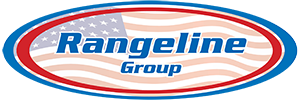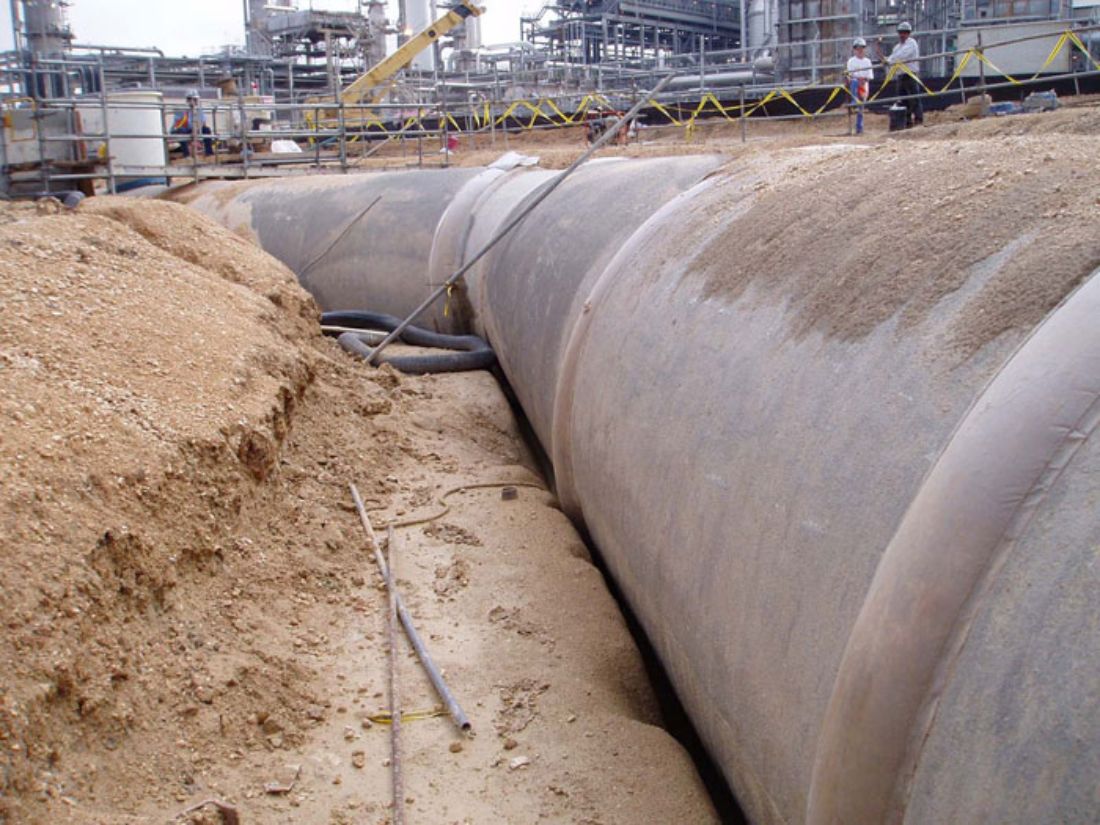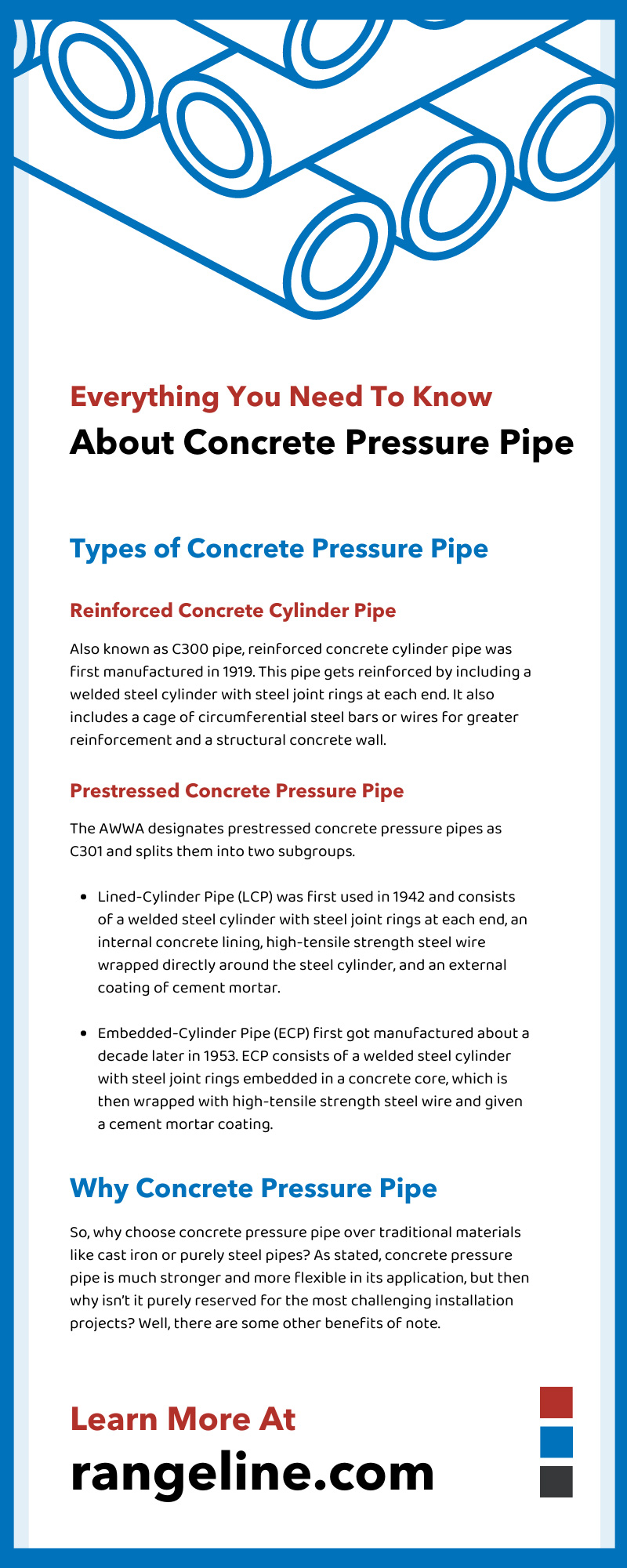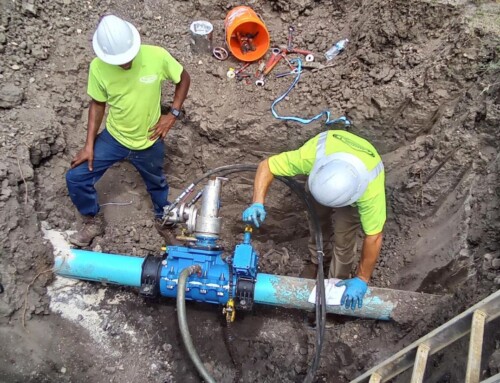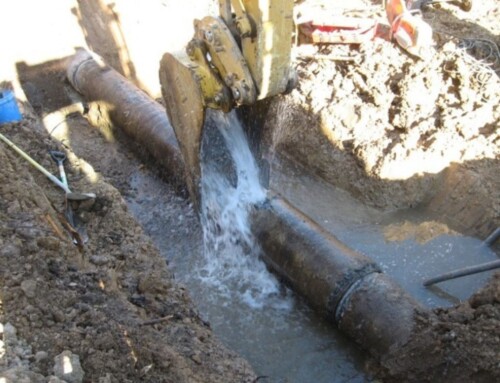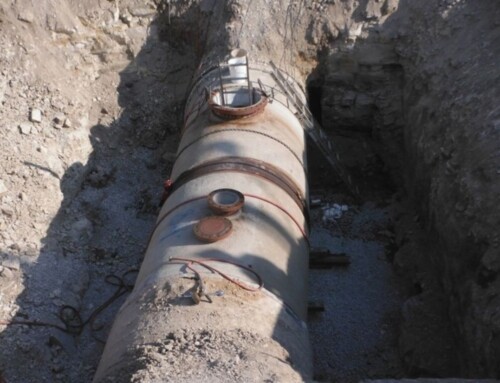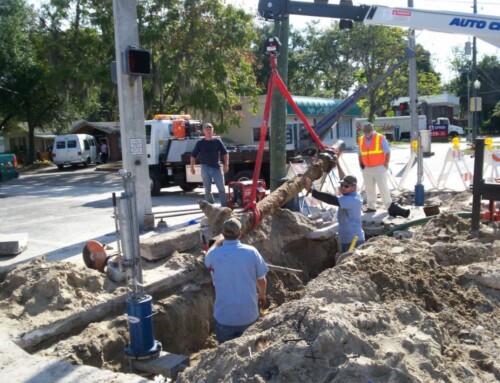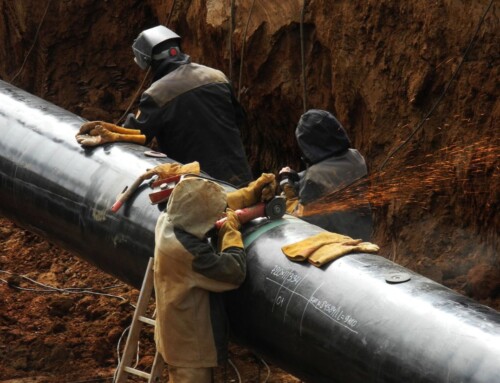To improve a structure or asset’s durability, civil engineers have been using steel and concrete in conjunction with one another so that the tensile strength of steel can complement the compressive strength of concrete. This same principle gets used by pipeline contractors to improve structural flexibility within our water and sewer systems.
When steel and concrete get applied this way in pipelines, it’s referred to as concrete pressure pipes (CPP). It is highly valued because concrete pressure pipes hold one of the longest performance histories and lowest failure rates of all pipe materials. Furthermore, concrete pressure pipes are incredibly flexible in their design, making it easy for contractors to design a pipeline that fits into tight spaces, runs the length of hilly terrain, or has precise sequencing requirements that don’t have any special bedding or backfill procedures. Now, with an understanding of the basics this material has to offer, here’s everything you need to know about concrete pressure pipe.
Types of Concrete Pressure Pipe
There are four types of concrete pressure pipe as defined by the American Water Works Association (AWWA).
Reinforced Concrete Cylinder Pipe
Also known as C300 pipe, reinforced concrete cylinder pipe was first manufactured in 1919. This pipe gets reinforced by including a welded steel cylinder with steel joint rings at each end. It also includes a cage of circumferential steel bars or wires for greater reinforcement and a structural concrete wall.
Prestressed Concrete Pressure Pipe
The AWWA designates prestressed concrete pressure pipes as C301 and splits them into two subgroups.
- Lined-Cylinder Pipe (LCP) was first used in 1942 and consists of a welded steel cylinder with steel joint rings at each end, an internal concrete lining, high-tensile strength steel wire wrapped directly around the steel cylinder, and an external coating of cement mortar.
- Embedded-Cylinder Pipe (ECP) first got manufactured about a decade later in 1953. ECP consists of a welded steel cylinder with steel joint rings embedded in a concrete core, which is then wrapped with high-tensile strength steel wire and given a cement mortar coating.
Reinforced Concrete Pressure Pipe
Designated as C302, reinforced concrete pressure pipe was first used in the early 1900s. This pipe consists of a cage of circumferential and longitudinal steel reinforcing bars or wires in addition to a structural concrete wall with steel or concrete joint rings at each end.
Bar-Wrapped Concrete Pressure Pipe
Lastly, called C303, bar-wrapped concrete pressure pipe was first manufactured and offered in the 1940s. C303 uses a welded steel cylinder with steel joint rings, an internal concrete or mortar lining, a spiral-wrapped reinforcing bar around the outside of the steel cylinder, and an external coating of cement mortar.
As you’ve noted by now, these different types of concrete pressure pipes are all reasonably similar in design, but with the exception of a few key differences. While the variations may seem small, this allows for the flexibility and customization needed for any given installation.
Why Concrete Pressure Pipe
So, why choose concrete pressure pipe over traditional materials like cast iron or purely steel pipes? As stated, concrete pressure pipe is much stronger and more flexible in its application, but then why isn’t it purely reserved for the most challenging installation projects? Well, there are some other benefits of note. For example, concrete pressure pipes are inherently resistant to corrosion – meaning that engineers and contractors would have to spend less time assessing and maintaining the pipelines. This, of course, is a great boon when there are miles of pipelines that form complex webs. Concrete pressure pipe typically lasts upwards of 90 years before needing maintenance or replacement because corrosion and general wear and tear have a harder time taking holding and eroding the durability of the pipes.
Furthermore, concrete pressure pipe is cheaper to make than other pipe materials, which is a fantastic benefit when you need to install pipes over great distances. Furthermore, a rigid conduit like concrete pressure pipes doesn’t need any special bedding or backfill for normal ground conditions. This saves a lot of money and time as a result.
Another benefit of concrete pressure pipe is the high-pressure capacity capable of handling internal and external loads. The concrete and steel walls get prestressed with high-strength steel while providing more than sufficient strength to manage the constant intense pressures pipelines get forced to endure around the clock.
To delve further into the customizability of concrete pressure pipes, it’s essential to know that concrete pressure pipe is a composite-engineered product that is custom designed for each application rather than being a “one size fits all” type of flexible. This is beneficial, however, as it ensures that the pipe provides the most efficient solution and reduces any excess or waste created trying to work with premade pipes.
Modern-Day Testing of CPP
The last thing you need to know about concrete pressure pipe is how it’s tested in the modern era to determine its physical characteristics or find any defects or damages. To test the physical properties of concrete pressure pipes and determine structural capacity, a pipe gets dissected for samples of the concrete, cylinder steel, and reinforcing rod. These samples are then mechanically tested to determine the material properties of each individual component. Once the test results are in, they’re used in conjunction with the pipeline’s configuration to reverse engineer the pipe’s design. This provides valuable information about the material properties and the capacity of the tested pipe section and helps determine if maintenance or replacements are in order.
Now that you’re better informed about concrete pressure pipe, you can find contracting services and more at Rangeline Group. As experts in pipeline maintenance and installation, you can depend on us for your next project. Our professional experts will also be happy to provide any additional information you may need before we proceed with the care and refurbishment of your pipes. Get in touch with us today!
